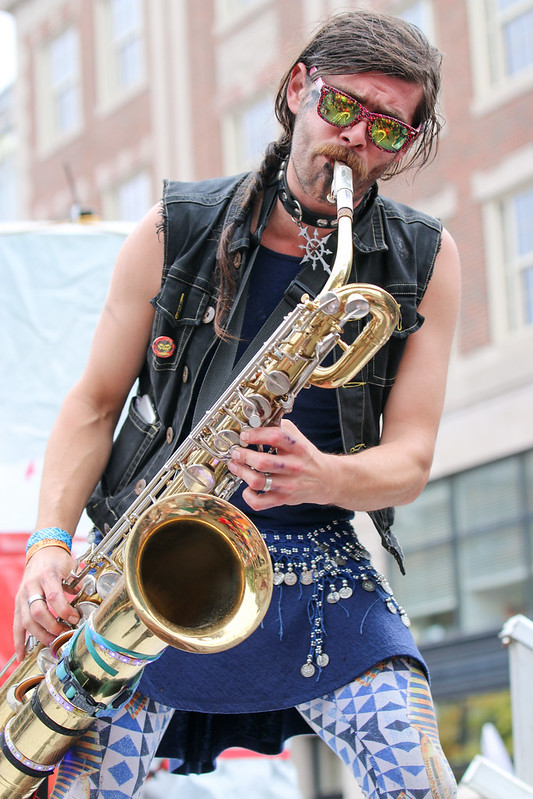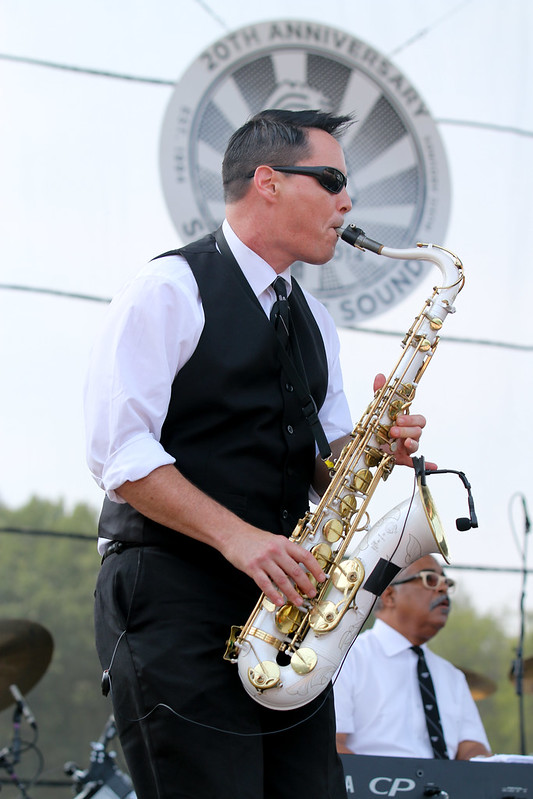For the purpose of this guide I will consider anything that a musician blows into to be a horn. A trumpet, trombone, flute, saxophone, jugs, and a melodica; all horns.

Unlike fiddler photography, the horn section/player is rarely the center of attention for more than a few seconds at a time. They are likely to be placed toward the back of the stage, and are rarely the attractive eye-catcher of the band (no offense, horn players). They are side players and therefore there are less opportunities to capture a horn player in action, increasing the overall difficulty of an acceptable shot.
The Trumpet
(including things that more-or-less look like a trumpet)
In terms of framing, the trumpet (and trumpeter) is the easiest form of horn photography. In theory the technique for trumpet photography is not unlike the techniques applied in fiddler photography. The instrument is similar in size and has a high risk of blocking the player’s eyes and face. As always, the focus of these photos is the players themselves, ideally the eyes, and not the instruments.
The simplest and safest shot, while still being pleasing, is a profile shot, which would show the entirety of the instrument while still capturing the face. It lends itself well to the preferred horizontal portrait.





Slightly more interesting is a near head-on shot where the focus sneaks around the horn to land on the player’s face. When done correctly the bell of the horn is blurred.




The Trombone
To the photographer, the trombone is a trumpet that changes shape. It has uses beyond the comical slide sound, I have been told. The technique, and desired result, is similar to that of a trumpet photographer. The one exception, or course, is the slide.
With the possible exception of an accordion, no other instrument can change shape as drastically as a trombone. Camera technology has yet to catch up to trombone technology as no camera is equipped to capture the entirety of a trombone while fully extended. Even the trombone in closed position teases to puncture a hole in the side of the photo’s frame.


The slide is cool, though I’m sure even the most advanced player would admit that it’s a bit gimmicky. No other horns have massive sliding parts. Most of them present sophisticated and modish buttons and values. Clearly they didn’t have the photographer in mind when the trombone was invented by the Europeans in the 15th century. And they knew to not even try to have them taken seriously as an early Trombone was referred to as a sackbut.
I find that it’s acceptable to lose the slide in the photo as long as the bell of the horn is in view.


Just like with the trumpet, I really like the head-on trombone shots. Since the slide is sliding towards the camera it doesn’t matter how long it grows, as long as it doesn’t boop the photographer’s camera in the process. It will always remain in frame.



The Saxophone
The most sought after saxophone shot involves a side shot of the player raising the horn into the air as beams of light transform the details into a beautiful silhouette. But expecting a shot like this is incredibly unlikely outside of the video for Kokomo.
In my opinion, Saxophone photography is the least satisfying style of horn photography. The horn lies parallel to the body, going down past the hip depending on the type of sax, and length of human. This means that in order to create an interesting photo that contains the majority of the horn in the photo, the shooter must shoot vertical shots.



Landscape saxophone photography works well when the player lifts the instrument above their heads. This is not a typical action of most saxophone players.


For trumpet and trombone photography, the face can be the center of focus, appearing large in the frame alongside a well-angled instrument. In order to have a large-in-the-frame face for saxophone photography there needs to be another aspect of the photo to make it interesting. A photo of just the player and the top of the saxophone is dull and lonely. It’s just a puffy faced cat and their popsicle stick, but no golden horn.
So what else can make it interesting? I came up with 2 ideas; a group of horn players, or when other stuff get in the way of the large-in-the-frame face.


The Tuba
(including things that more-or-less look like a tuba)
The tuba player replaces the bass player in mobile live music. They can also serve as a replacement for the person who holds a sign containing the band’s name, or general message. Anything can be written on the tuba’s horn.





The tuba’s bell is again the star of the show. Since the player doesn’t move around much, there’s no challenge in focusing on the face versus focusing on the bell as they’re on the same plane. Any shot that contains the bell, and the person’s torso, is probably acceptable.
Another fun aspect of the tuba is that if the bell isn’t used for advertising purposes, it can reflect the crowd if kept shiny.

Other Things to Blow Into




Final Thoughts
I played the saxophone in high school and college. While fun in a group, it’s an instrument that requires a lot of dedication to play and practice alone. It’s far easier to photograph a horn player, then become one.
Horns can be tiresome to play, and apparently, sometimes fatal. Toot with caution.


All photos by Jason McGorty. This entry is one of a larger set of Definitively Unprofessional Guides to niche photography subjects.
Disclaimer: The information contained in this website is for general information purposes only. I don’t know why I was so hard on trombones. I really like them, and respect the difficulties in playing them melodically.
What makes a good photograph is completely subjective and the views expressed in this guide are that of the author only.

Looking at your horn photography…I can hear them..nice work!!
LikeLike